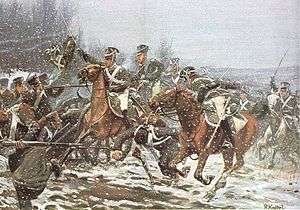Battle of La Rothière
The Battle of La Rothière was fought on the 1st of February 1814 between the French Empire and allied army of Austria, Prussia, Russia, and German States previously allies with France. The French were led by Emperor Napoleon and the coalition army was under the command of Gebhard Leberecht von Blücher. The battle took place in severe weather conditions (wet snowstorm). The French were defeated but managed to hold until they could retreat under cover of darkness.
| Battle of La Rothière | |||||||
|---|---|---|---|---|---|---|---|
| Part of the War of the Sixth Coalition | |||||||
 Württemberg dragoons charging French infantry | |||||||
| |||||||
| Belligerents | |||||||
|
|
| ||||||
| Commanders and leaders | |||||||
|
|
| ||||||
| Strength | |||||||
| 110,000 |
45,000 128 guns | ||||||
| Casualties and losses | |||||||
| 6,000–7,000 dead or wounded[1] |
4,600 dead or wounded 1,000 captured 73 guns[1] | ||||||
Prelude
On the 25 January 1814, Blücher entered Nancy, and, moving rapidly up the valley of the Moselle, was in communication with the Austrian advanced guard near La Rothière on the afternoon of the 28 January.[2]
On 29 January Napoleon attacked the Prussians. Blücher's headquarters were surprised and he himself nearly captured by a sudden rush of French troops (Battle of Brienne). Learning at the same time that the French Emperor in person was at hand, Blücher accordingly fell back a few miles next morning to a strong position covering the exits from the Bar-sur-Aube defile.[2]
The Austrian advance guard joined the Prussians and together they decided to accept battle—indeed they had no alternative, as the roads in rear were so choked with traffic that retreat was out of the question.[2]
Order of battle
The French army counted about 45,000 men in 57 battalions and 62 squadrons, supported by 128 artillery pieces. The Imperial Guard was commanded by General of Division Philibert Jean-Baptiste Curial. Marshal Claude Perrin Victor led the II Corps with three infantry divisions under Generals of Division François Antoine Teste, Jean Corbineau, and Georges Mouton. General of Division Emmanuel Grouchy led the cavalry.[3]
On the Coalition side, Prince Scherbatov led the Russian 6th Corps, General-Leutnant Zakhar Dmitrievich Olsufiev directed the Russian 9th Corps, Count Liewen III commanded the Russian 11th Corps, Feldzeugmeister Ignaz Gyulai led the Austrian 3rd Corps, Crown Prince Frederick William of Württemberg directed the 4th Corps, General der Kavallerie Karl Philipp von Wrede commanded the Austro-Bavarian 5th Corps, and there were several independent cavalry divisions.[3]
The multinational coalition forces used white shoulder bands to distinguish friends from foes during the battle.
Battle
About noon the 2 February Napoleon attacked, but the weather was terrible, and the ground so heavy that his favourite artillery, the mainstay of his whole system of warfare, was useless and in the drifts of snow which at intervals swept across the field, the columns lost their direction and many were severely handled by the Cossacks. At nightfall the fighting ceased and the French retired to Lesmont, leaving Marmont behind to observe Coalition movements.[2]
Historian Digby Smith stated that French losses numbered 4,600 killed and wounded. The Coalition captured an additional 1,000 soldiers and 73 guns. The large loss of artillery was partly due to Coalition cavalry superiority and partly due to the soggy condition of the ground, which made it difficult to withdraw the pieces. The Coalition lost between 6,000 and 7,000 casualties.[1]
Aftermath
From Lesmont, the French moved to Troyes. Owing to the state of the roads, more perhaps to the extraordinary lethargy which always characterized Schwarzenberg's headquarters, no pursuit was attempted.[2]
Analysis
The result of this battle filled the allies with joy. They had captured 50 guns and 2,000 prisoners, and 4,000 dead or wounded Frenchmen littered the plain, but it was not these trophies or these hecatombs which raised their spirits to such a height: they themselves had had 6,000 men mown down by the grape shot; but they had overthrown Napoleon in fair fight on the soil of France; the charm which had been broken at Leipzig had not been restored, and it was again proved that the Emperor was not invincible. In face of the enormous forces which they had available, the Emperor was as good as beaten unless he were invincible.
— Henry Houssaye.[4]
Notes
- Smith 1998, p. 492.
- Maude 1911, p. 232.
- Smith 1998, p. 491-492.
- Houssaye 1914, pp. 50–51.
References
- Smith, Digby (1998). The Napoleonic Wars Data Book. London: Greenhill. ISBN 1-85367-276-9.CS1 maint: ref=harv (link)
- Houssaye, Henry (1914). Napoleon and the campaign of 1814. Translated by McClintock, R.S. Hugh Rees. pp. 50–51.CS1 maint: ref=harv (link)
Attribution:

Further reading
- Chandler, David G. (1966). The Campaigns of Napoleon. New York, NY: Macmillan.
- Chandler, David G. (1999). Dictionary of the Napoleonic Wars. New York, N.Y.: Wordsworth.
- Nafziger, George (1994). "Allied Forces, Battle of La Rothière, 1 February 1814" (PDF). United States Army Combined Arms Center. Archived from the original (PDF) on 2016-03-03. Retrieved 2016-02-21.
- Petre, F. Loraine (1994) [1914]. Napoleon at Bay: 1814. London: Lionel Leventhal Ltd. ISBN 1-85367-163-0.